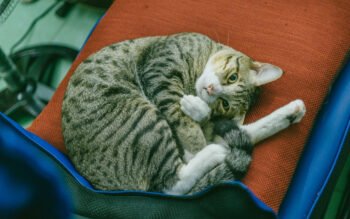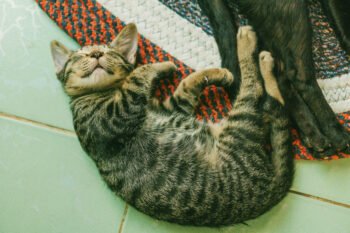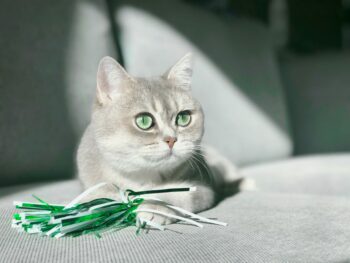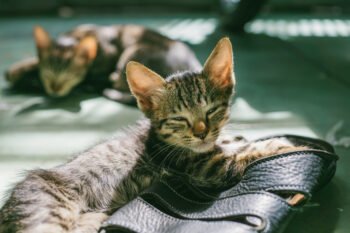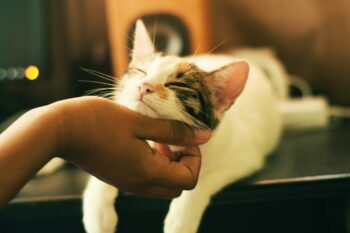When cat lovers open one of Bob Walker’s many books (which include The Cat’s House, Cats Into Everything, and most recently, Cats Are Purr-fect), they usually feel a thrill of recognition. In riveting color photos, Walker captures the silly, messy, sleepy, playful, wild, greedy, scary, and goofy creatures that are cats. Part of Walker’s secret in capturing the elusive cat soul on film is that he and his wife, Frances Mooney, have transformed their home into a fabulous feline paradise. Brightly colored walkways span the walls, cats race up and down ramps and escape into other rooms through exits near the ceilings that are whimsically shaped like, well, mouse holes. Just about every room in the house has brightly colored ramps and tunnels and terraces and walkways designed to turn it into a kitty jungle gym.
At present, Walker and Mooney count 11 cats in their 1,500-square-foot house in San Diego, California. The oldest cat is 11 years old; the youngest is two. And although Walker has said in the past that he likes to introduce a new kitten whenever things get too calm, he and Mooney are determined to resist any new feline additions for awhile. Instead, they are continually working on new projects, which range from a new series of postcards to adding some wheelchair ramps to their home, so that even more people may come and see how great a cat’s life can truly be. (They periodically hold open houses, when the public can visit and enjoy their ongoing feline decorating project.)
We chatted with Walker recently about the ultimate feline habitat he and his wife have built.
 Q: How did you come up with the idea of putting in catwalks?
Q: How did you come up with the idea of putting in catwalks?
A: When I was young, I remember visiting an uncle who had one of those train sets that go around the room, and everybody who has cats knows that they love to be up high — they always love to get to the top of whatever — so it was just a natural thing. We built a scratching column that was 395 feet of sisal rope wrapped around [wood], and the cats would run full speed up this scratching column and then come to a dead end. We started just expanding it and now there are 140 feet of cat paths throughout the house. It was something we did for our cats, our family, and the media got hold of it and thought it was wonderful. We started having open houses and then I did a book, and now we’ve had at least 25 film crews here. Honestly, if you can get to that point where you just don’t worry about what other people think and you do it for your own life and you put holes in your walls — what could happen?
Q: Are there some general rules you used to build the catwalks?
A: Make sure when you build a catwalk that you don’t hug the walls with it. When you get wide-bodied cats, they can’t turn around. They have to do some sort of contortionist flip. They put their head between their back legs and then flip around if they want to turn around the other way. And you must have more than one way to get up and down, because otherwise you’ll get road hogs who will just lay there and not budge an inch.
 Q: And you actually cut holes through your walls to create more space?
Q: And you actually cut holes through your walls to create more space?
A: Way back, I kidded that we probably did about $10,000 worth of work and we probably devalued the house by $25,000.
Q: Do you have what people think of as “normal” cat furniture, like cat trees?
A: No, we don’t have any of that. I’m one of the cat trees. I have a couple of cats who like to jump on me and get on my shoulder and walk around. All of my T-shirts that I usually wear have little holes in the shoulders, so that’s just our lifestyle.
Q: Looking at your books, I was struck by the fact that you’ve created all these cat walks, but the cats also seem to play in the bathtub, on tables — the whole house seems to be their playground.
A: Well, that was one of the premises of the whole project. Usually people go off to school or to work leaving the house to the animals, so if possession was nine-tenths of the law, it would really be their house. The least you can do is consider their needs and make [the house] wonderful.
 Q: Did you make any mistakes over the years?
Q: Did you make any mistakes over the years?
A: Absolutely. Frances always goes to thrift stores and she was getting hundreds of stuffed cats of all sizes and shapes, so we thought, oh, that would be really fun, we’ll just make a cat column out of [toy] cats. So we made this column up to the cat walk and we screwed in all these little stuffed animals around it. And the cats did not use it at all-they wouldn’t climb it. It gives too much; there’s no footing there. So in Cats Into Everything, I show a series of [photos of] Frances seated where all of a sudden she’s getting more and more cats surrounding her, all these stuffed cats, and she’s totally consumed in a big pile, with just her eyes looking out at one point. That was a fun photograph. But we admit our failure there.
Q: How safe are these cat adaptations?
A: We’ve only had one injury in all of the years, from a kitty falling down. We’ve had a couple knock their wind out, so that’s a caution for people. One time one of our kitties tried to go into an opening — we reconstructed [the story] later — that she couldn’t fit into because she had outgrown her cat-opening size, so she fell down and broke a leg. That was when we had one of our first open houses and I thought, “Oh my God, everybody’s coming over here and they’re going to see a cat with a broken leg — this is really an endorsement.”
Q: How do you handle litterboxes and food?
A: Feed ’em a heck of a lot and clean their boxes every day. One of our phrases is that our cats are always one meal away from starvation.
 Q: What sort of playtime do you have with them?
Q: What sort of playtime do you have with them?
A: Well, we live and work at home, so our cats are spoiled rotten. I have my office in one of the rooms; it’s actually a cat-free zone. I had to replace a couple of floppy drives [in my computer] because of cat hair. We also do custom picture framing for museums and things like that, so you can’t really have your kitties wanting to lie on artworks or scratch their toes or something like that, so we do have a separation. But some of them just sit outside of my door yowling, “Bob, it’s time to come out.” They get so much attention all the time because we’re both here, so they get petted a lot and they all think that’s normal.
Q: And how do you keep the cat hair down?
A: We don’t.
Q: I know you’ve designed everything in your house with a definite sense of humor. Do you think the cats appreciate that?
A: Oh, I would think so. We all know that cats have a limited color sensibility, and one of our ideas is that if you oversaturate the colors then you’re giving them a more colorful life.

